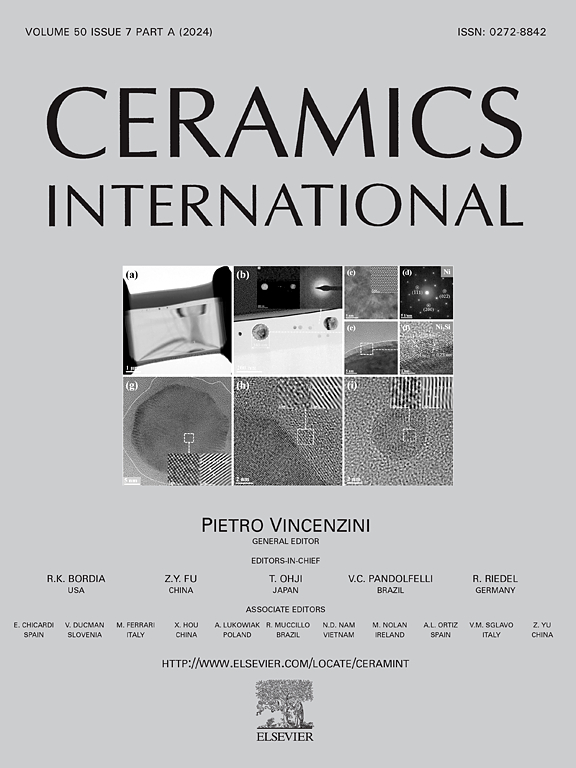结合碳纳米管的TiN涂层在油水润滑中的协同润滑行为
IF 5.1
2区 材料科学
Q1 MATERIALS SCIENCE, CERAMICS
引用次数: 0
摘要
采用多弧离子镀技术在M50NiL基板上沉积氮化钛(TiN)涂层,提高了M50NiL基板在高接触应力下的摩擦学性能。对TiN涂层的显微组织和力学性能进行了表征,结果表明,TiN涂层的硬度和弹性模量分别提高到33 GPa和400 GPa。利用球盘式摩擦计研究了TiN涂层与Si3N4陶瓷摩擦的摩擦学行为。在干摩擦条件下,在2.3 GPa的高接触应力下沉积TiN后,其耐磨性提高了60.5%。同时制备了分散稳定性良好的碳纳米管纳米润滑剂。在水润滑条件下,当添加0.2 wt%的CNTs后,TiN涂层与Si3N4陶瓷摩擦时,摩擦系数(COF)和磨损疤痕直径(WSD)分别降低了15.6%和8.7%。在油润滑条件下,CNTs的加入使COF和WSD分别降低了5.5%和12.6%。研究结果有助于CNTs作为添加剂在混合陶瓷轴承润滑中的实际应用。本文章由计算机程序翻译,如有差异,请以英文原文为准。
Synergistic lubrication behavior of TiN coatings integrated with CNTs for oil and water lubrication
The titanium nitride (TiN) coating was deposited on the M50NiL substrate by using a multiarc ion plating technique to enhance tribological performance under high contact stress. The microstructure and mechanical properties of the TiN coating were characterized and results demonstrated that the hardness and modulus of elasticity were enhanced to 33 GPa and 400 GPa, respectively. The tribological behavior of TiN coatings sliding against Si3N4 ceramic was investigated by using a ball-on-disc tribometer. Under dry friction, the wear resistance property was improved by 60.5 % after TiN deposition at high contact stress of 2.3 GPa. Meanwhile, carbon nanotubes (CNTs) nano-lubricants with good dispersion stability were prepared. Under aqueous lubrication, the coefficient of friction (COF) and wear scar diameter (WSD) decreased by 15.6 % and 8.7 %, respectively, after adding 0.2 wt% CNTs when TiN coatings slid against Si3N4 ceramic. Under oil lubrication, the COF and WSD decreased by 5.5 % and 12.6 %, respectively with the addition of CNTs. The findings contributed to the practical application of CNTs as additives in hybrid ceramic bearings lubrication.
求助全文
通过发布文献求助,成功后即可免费获取论文全文。
去求助
来源期刊

Ceramics International
工程技术-材料科学:硅酸盐
CiteScore
9.40
自引率
15.40%
发文量
4558
审稿时长
25 days
期刊介绍:
Ceramics International covers the science of advanced ceramic materials. The journal encourages contributions that demonstrate how an understanding of the basic chemical and physical phenomena may direct materials design and stimulate ideas for new or improved processing techniques, in order to obtain materials with desired structural features and properties.
Ceramics International covers oxide and non-oxide ceramics, functional glasses, glass ceramics, amorphous inorganic non-metallic materials (and their combinations with metal and organic materials), in the form of particulates, dense or porous bodies, thin/thick films and laminated, graded and composite structures. Process related topics such as ceramic-ceramic joints or joining ceramics with dissimilar materials, as well as surface finishing and conditioning are also covered. Besides traditional processing techniques, manufacturing routes of interest include innovative procedures benefiting from externally applied stresses, electromagnetic fields and energetic beams, as well as top-down and self-assembly nanotechnology approaches. In addition, the journal welcomes submissions on bio-inspired and bio-enabled materials designs, experimentally validated multi scale modelling and simulation for materials design, and the use of the most advanced chemical and physical characterization techniques of structure, properties and behaviour.
Technologically relevant low-dimensional systems are a particular focus of Ceramics International. These include 0, 1 and 2-D nanomaterials (also covering CNTs, graphene and related materials, and diamond-like carbons), their nanocomposites, as well as nano-hybrids and hierarchical multifunctional nanostructures that might integrate molecular, biological and electronic components.
 求助内容:
求助内容: 应助结果提醒方式:
应助结果提醒方式:


